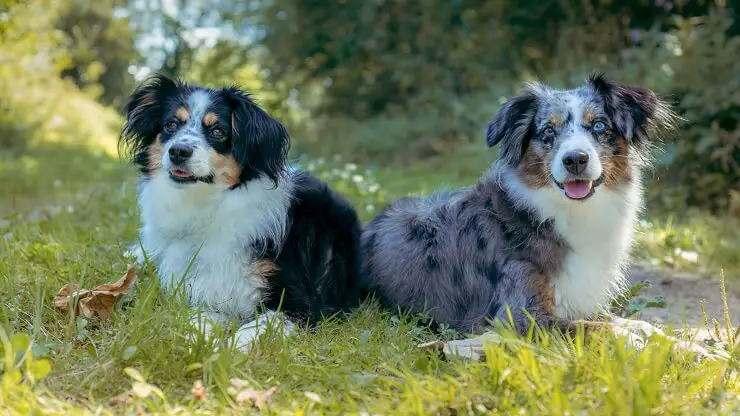
From Adobe Stock
One day, while walking Oscar in the park, we met a Mini Australian Shepherd named Luna. She was lively, darting around with so much energy and intelligence in her bright eyes. It was fascinating to watch her interact, showing traits that make her breed stand out: her agility, loyalty, and how quickly she responded to commands.Mini Australian Shepherds, like Luna, are captivating creatures. They are smaller versions of the Australian Shepherd, packed with energy, intelligence, and a strong desire to please their owners. In this article, I’ll share insights about the Mini Australian Shepherd, drawing from my experiences and observations. You’ll learn about their temperament, needs, and why they might be the perfect addition to your family.
TABLE OF CONTENTS
- Mini Australian Shepherd Quick Breed Summary
- History and Origin of the Mini Aussie
- Physical Characteristics of the Mini Australian
- Mini Australian Shepherd Personality and Temperament
- Mini Australian Shepherd: What is the Difference?
- Common Health Concerns for the Mini Aussie
- Caring for a Miniature Australian Shepherd
- FAQs on the Mini Aussie
- The Unconditional Love and Loyalty of a Mini Aussie
Mini Australian Shepherd Quick Breed Summary
| Common Breed Names: | Mini Australian Shepherd, Mini Aussie, Miniature Australian Shepherd |
| Size: | 14-18 inches |
| Weight: | 20-40lb |
| Lifespan: | 11-15 years |
| Coat: | Long double coat |
| Color: | Black, brown, red, white, tan, and merle |
| Do They Shed: | Yes |
| Temperament: | Lovable, loyal, hardworking, eager, and helpful |
| Intelligence: | High |
| Socialization: | Uneasy around others (early socialization is needed) |
| Destructive Behavior: | Chewing, tearing, or knocking over furniture |
| People Skills: | Very devoted and protective to their families |
| Good with Children: | Yes |
| Activity Levels: | Very high |
History and Origin of the Mini Aussie
Despite its name, this breed was developed in the United States, not Australia. This fact alone sparked my curiosity. It turns out that the breed traces back to the late 19th and early 20th centuries when Basque shepherds, moving from Australia to America, brought with them their prized Australian Shepherds. These dogs were renowned for their herding prowess, something I’ve always admired in herding breeds.
I’ve also learned that breeders in the United States wanted a dog that kept the Australian Shepherd’s intelligence and versatility but in a smaller package. Thus, the Mini Australian Shepherd was born. This initiative wasn’t just about size; it was about creating a dog that fit modern lifestyles while retaining the heart and soul of a working dog. Having spent countless hours observing and interacting with different breeds, I can attest to the Mini Aussie’s ability to adapt to various roles, from companionship to competitive sports. Their story is not just a chapter in the book of herding dogs, but a reflection of human ingenuity in breeding purebred dogs that fit into our changing world.
Physical Characteristics of the Mini Australian
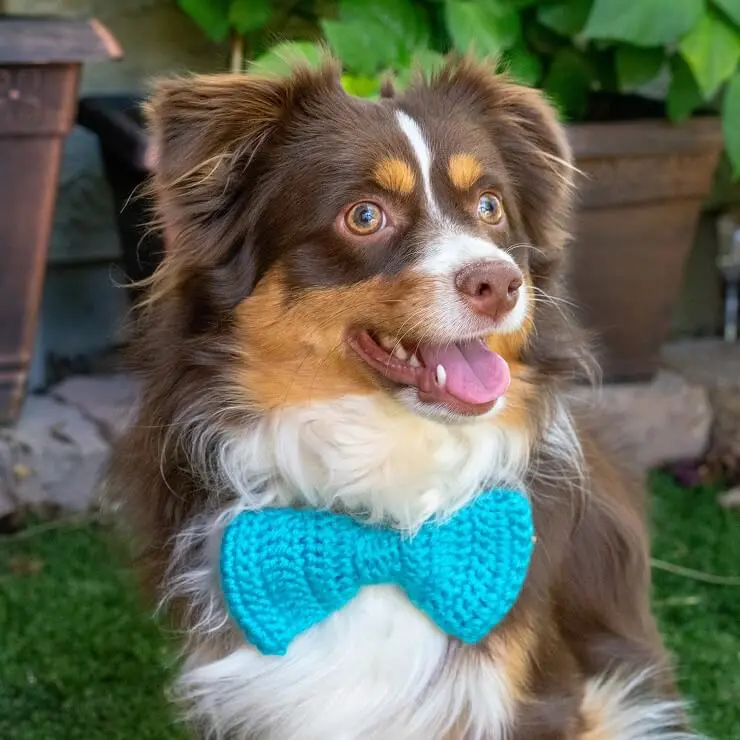
From Adobe Stock
I’ve always been fascinated by the Mini Aussies’ stunning coats. Their long, wavy double coat is not just a protection against the elements; it’s a hallmark of their breed, showcasing a variety of colors. Whether tri-colored, bi-colored, or sporting a single color with striking white accents, each Mini Aussie’s coat is unique. Their broad chests and muscular bodies are a testament to their strength, despite their compact size. And their eyes! From brown to blue or even heterochromia, their gaze is always captivating. The contrast of their dark base color with lighter patches and a bright white underside is something I’ve found both beautiful and distinctive.
Height and Weight
From my experience, the Mini Aussies, closely related to the Border Collie, is the perfect middle ground in size. Standing between 14 and 18 inches tall, these dogs are small enough to fit into various living situations but large enough to hold their own in agility and herding activities. The weight range, 20-40 pounds, underscores their solid, well-built nature. I’ve learned to appreciate the breed’s standard, which emphasizes a balance in size to ensure they’re recognized as the robust working dogs they are, not mistaken for a toy breed.
Colors
The color variations within the Mini Aussie breed are truly something to behold. The base colors of black or reddish-brown serve as a canvas for white, tan, and beige patches, creating each dog’s unique pattern. Merles, with their mottled appearance, is particularly striking. A black coat turning into bluish-gray in a blue merle Miniature Australian is a sight to behold.
Coat
The breed’s double coat, with its thick outer layer and soft undercoat, is not just for show. It’s a functional feature that I’ve noticed provides insulation and protection. Whether straight or wavy, the coat’s texture and quality are something I pay close attention to, as they reflect the dog’s health and care.
Head and Face Shape
I’ve come to admire the proportional balance between a Mini Aussie’s head and body. It reflects the breed’s harmony and symmetry, traits that are essential not just for appearance but for their physical capabilities. Their expressive faces, framed by their distinctive coat and color patterns, reveal a lot about their personality and mood.
Mini Australian Shepherd Personality and Temperament
I’ve learned firsthand that Mini Aussies are indeed little bundles of energy and intelligence. Their work ethic is something to be admired; they thrive on having tasks to complete. Whether it’s herding, agility training, or simply playing fetch, they pour their heart and soul into every activity. I’ve seen that if they aren’t given enough to do, they can become quite the mischief-makers. A bored Mini Aussie in my experience will find ways to entertain themselves, often at the expense of your furniture or personal belongings.
Keeping them engaged is key. With the right mix of activities, a Mini Aussie transforms into the most affectionate and loyal companion. Their devotion to keeping their family safe is unmatched. I’ve spent countless hours with Mini Aussies, running, hiking, and playing, and their stamina always impresses me. Their zest for life is infectious.
It’s true, they tend to be quiet when their needs are met. However, excessive barking is a signal to me that something’s amiss—either they’re alarmed, under-stimulated, or something in their environment is off. Their alertness is incredible. I’ve noticed they’re always on guard, making them superb watchdogs. Introducing new people requires patience and understanding from their owners, as Mini Aussies are naturally cautious. But once they understand someone is a friend, their loyalty extends to them as well.
Regarding other pets, their herding instinct can indeed lead to challenges. They don’t just chase balls; smaller pets and even larger dogs can become targets of their herding behavior. I’ve seen Mini Aussies try to herd everything from birds to children. It’s important to guide this behavior correctly, ensuring they understand when it’s appropriate to herd and when it’s not.
Their attention to detail is something I’ve always been amazed by. Mini Aussies seem to notice everything, always aware of their surroundings and ready to protect their loved ones at a moment’s notice. Their intelligence and eagerness to please make them not just pets, but integral members of the family, always watching out for their human pack.
American Shepherd Vs. Mini Australian Shepherd: What is the Difference?

From Adobe Stock
I’ve often been asked about the difference between Miniature Australian Shepherds and American Shepherds. It’s a topic that can get a bit confusing, given how similar these two breeds are in appearance and temperament. The crux of the matter really comes down to their recognition by the American Kennel Club (AKC).
From what I’ve gathered over the years, the Miniature Australian Shepherd was developed from the Australian Shepherd breed to create a smaller version of the dog without sacrificing its work ethic or personality. These dogs are energetic, intelligent, and incredibly loyal, traits that they share with the larger Aussie Shepherds.
The twist in the tale came when breed enthusiasts sought AKC recognition for the Miniature Australian Shepherd. The AKC recognized the breed under a new name: the Miniature American Shepherd. This change was primarily to distinguish the breed as distinct and to align with AKC’s breed recognition policies. Thus, the Miniature American Shepherd became an officially recognized breed, while the Miniature Australian Shepherd continued to be recognized by other clubs but not the AKC.
I’ve found both Mini Aussies and American Shepherds to be delightful companions. They share the same zest for life, intelligence, and eagerness to engage in activities with their humans. Both breeds are highly trainable and excel in various dog sports, from agility to obedience. Their temperaments are so similar that, without the context of their breed names, distinguishing between the two based on behavior alone would be a challenge.
The key difference, then, isn’t about personality or capability but about formal recognition. For those in the dog world who participate in AKC events or who value AKC registration for breeding purposes, the distinction is significant. For most pet owners, however, what matters more is the fit of the dog’s temperament and energy levels with their lifestyle, not the name under which their breed is registered.
Common Health Concerns for the Mini Aussie
I’ve encountered several health concerns that potential owners should be aware of. This knowledge not only helps in early detection and management but also in making informed decisions when choosing a breeder. Below, I’ll share insights into some of the health issues prevalent in Mini Aussies, including their symptoms and causes.
Hip Dysplasia
Hip dysplasia is a common concern in Mini Australian Shepherds, just as it is with many other breeds. This condition involves an abnormal formation of the hip joint, leading to arthritis and pain. Symptoms can include difficulty standing up, reluctance to jump or climb, and a noticeable limp. I’ve seen dogs struggle with this, and it’s heartbreaking. The cause is typically genetic, though factors like diet and rapid weight gain can exacerbate the issue.
Epilepsy
Epilepsy is another health issue that Mini Aussies can face. It’s a neurological disorder that can cause seizures, ranging from mild to severe. Watching a dog experience a seizure is distressing, and I’ve had to comfort more than one owner through this. The causes of epilepsy can be genetic, environmental, or sometimes unknown. Management usually involves medication and monitoring, which can help control seizures and maintain quality of life.
Progressive Retinal Atrophy (PRA)
Progressive Retinal Atrophy is a genetic condition I’ve come across in some Mini Aussies, leading to gradual vision loss and eventually blindness. The first sign is often night blindness, progressing to difficulty seeing in bright light. Since it’s hereditary, there’s no cure, but affected dogs can live full lives with adjustments to their environment.
Collie Eye Anomaly (CEA)
Collie Eye Anomaly is another hereditary condition that can affect Mini Aussies. It involves abnormal development of the eye, which can range from mild to severe, potentially leading to blindness. Symptoms are hard to spot without a veterinary exam since dogs often adapt to their visual limitations. I always stress the importance of early eye screening for this reason.
Multi-Drug Resistance 1 (MDR1)
The MDR1 gene mutation is something I’ve learned to be vigilant about in Mini Aussies. It makes them sensitive to certain medications, which can be dangerous or even fatal. Symptoms of a reaction include lethargy, drooling, unsteadiness, and seizures. Knowing a dog’s MDR1 status can save its life, as it allows veterinarians to choose safe medications. It’s a clear example of how modern genetics can impact veterinary care.
Caring for a Miniature Australian Shepherd
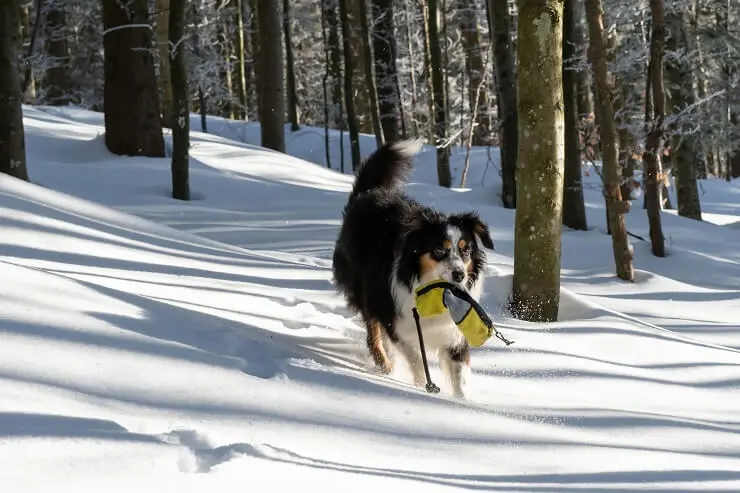
From Adobe Stock
Caring for a Mini Aussie goes beyond just love and companionship; it’s about understanding their needs and ensuring they lead a balanced, healthy life. From my own experiences, I’ve learned that these energetic dogs require a specific approach to exercise, mental stimulation, training, feeding, and grooming. Let’s dive into what makes caring for these vibrant dogs both a challenge and a joy.
Exercise
The Mini Aussie’s love for the outdoors and activity isn’t just a preference; it’s in their DNA. Taking mine out for hikes or long walks, I’ve seen how much they relish exploring and moving. An hour of walking, split into two sessions, plus an additional 30 minutes of playtime, seems to be the sweet spot. Their herding instinct can kick in unexpectedly, so I always keep them leashed unless we’re in a safe, enclosed area. At home, they’re eager to help with tasks, proving themselves as invaluable helpers. Whether it’s fetching something or simply being by your side, they thrive on being involved.
Mental Stimulation
Mental stimulation is just as important as physical exercise for a Mini Aussie. These intelligent dogs get bored easily, so I’ve found that engaging them with puzzles, training exercises, and games keeps their minds sharp. Teaching them new tricks or setting up a small obstacle course in the backyard can be great ways to keep them mentally engaged. Their willingness to learn and solve problems is astounding, and it’s rewarding to see them figure things out.
Training a Mini Aussie
Training a Mini Aussie, from my perspective, is more about building a bond than enforcing commands. Their desire to please and intelligence make the process smoother, but it’s essential to approach training with patience and positivity. I’ve noticed that they respond best to praise and affection, viewing every successful command as a win for our team. Early socialization is crucial; exposing them to different people and dogs helps them become well-adjusted adults. Creative play, like varying the game of fetch, not only trains them but also keeps their minds and bodies active.
Feeding
Understanding the dietary needs of a Mini Aussie is critical for their health and happiness. High-quality food that’s rich in nutrients and appropriate for their energy level is essential. Here are helpful guidelines:
Provide High-Quality Dog Food
Selecting high-quality dog food is essential. Look for formulas that list real meat as the first ingredient and are tailored to meet the nutritional needs of active breeds. Avoid foods with unnecessary fillers or artificial additives, as these can negatively impact their health.
Check Portion Size and Frequency
Mini Aussies benefit from controlled portion sizes to prevent obesity—a condition that can lead to other health issues. Typically, an adult Mini Aussie requires about 1 to 1.5 cups of dry dog food per day, divided into two meals. However, this can vary based on the dog’s age, weight, and activity level. Puppies, who are growing rapidly, may need more frequent feedings, typically three to four times a day.
Adjust to Suit Activity Level
Given their high energy, Mini Aussies involved in regular, vigorous activities may require additional calories. Adjust their food intake accordingly, ensuring they’re getting enough energy without overfeeding. Consult with a veterinarian to determine the ideal caloric intake for your dog’s lifestyle.
Monitor Weight and Health
Regularly monitor your Mini Aussie’s weight and overall health, adjusting their diet as needed. A healthy weight is crucial for preventing joint issues, such as hip dysplasia, which can be exacerbated by obesity. Feel for their ribs; you should be able to sense them beneath a thin layer of fat for an ideal weight.
Follow Special Dietary Considerations
Some Mini Aussies may have food sensitivities or allergies. If you notice signs of digestive upset or skin issues, consult a vet to see if a dietary adjustment or a special formula is needed. There are various hypoallergenic and limited-ingredient diets available that cater to dogs with specific dietary needs.
Ensuring your Mini Aussie has access to fresh, clean water at all times is equally important.
Grooming
Grooming a Mini Australian Shepherd is essential not just for their appearance but for their overall health and comfort. Based on what I’ve learned from other owners and experts, here are some detailed guidelines:
Regular Brushing
Mini Aussies have a beautiful double coat that requires regular maintenance to keep it healthy and free of mats. It’s recommended to brush them at least a few times a week, though daily brushing is ideal during shedding seasons (spring and fall). Using a de-shedding tool or undercoat rake can significantly reduce the amount of loose fur and help prevent their coat from tangling.
Bathing
While Mini Aussies don’t need frequent baths, they should be bathed every few months or when they get particularly dirty. Using a dog-specific shampoo that’s gentle on their skin will help keep their coat shiny and healthy without stripping natural oils. It’s important to ensure they’re completely dry after bathing to avoid any skin irritations.
Nail Trimming
Nail care is crucial for the Mini Aussie’s comfort and health. Overgrown nails can cause pain and lead to problems with walking or running. Many owners I’ve spoken with aim to trim their dog’s nails every 3-4 weeks, though this frequency can vary depending on how quickly their nails grow and how much natural wear they get from outdoor activities.
Ear Cleaning
Checking and cleaning their ears regularly can prevent infections, especially in dogs that love to swim or play in the dirt. A gentle ear cleaner recommended by veterinarians can be used to wipe out the ear canal, ensuring no moisture or debris is left behind.
Dental Care
Good dental hygiene is another vital aspect of grooming. Brushing their teeth several times a week with dog-specific toothpaste can prevent tartar buildup and gum disease. Many Mini Aussie owners also use dental chews as an additional way to help keep their dog’s teeth clean.
FAQs on the Mini Aussie
What kind of exercise does a mini Aussie need?
Mini Aussies are high-energy dogs that thrive on activity and mental stimulation. They require at least 90 minutes of exercise per day, including walks, playtime, and other activities like agility training or fetch. This breed loves tasks that challenge both their body and mind, so incorporating training sessions into playtime can be especially beneficial.
Are mini Australian shepherds good with children?
Yes, Mini Aussies can be great companions for children, thanks to their playful nature and boundless energy. However, due to their herding instincts, they may try to herd small children by nipping at their heels. It’s important to supervise interactions and teach both the dog and children how to interact safely and respectfully.
Can mini Aussies live in apartments?
While Mini Aussies are adaptable and can live in apartments, their high energy levels and need for regular exercise mean they are best suited to homes with more space, such as a house with a yard. If living in an apartment, owners should commit to providing sufficient daily exercise and mental stimulation.
What health issues should I be aware of?
Mini Aussies are generally healthy, but like all breeds, they can be prone to certain health issues. These include hip dysplasia, epilepsy, progressive retinal atrophy (PRA), and collie eye anomaly (CEA). Prospective owners should ensure their dog comes from a reputable breeder who conducts genetic testing on their breeding stock.
How do I train my mini Aussie?
Mini Aussies are intelligent and eager to please, making them relatively easy to train. They respond best to positive reinforcement techniques such as treats, praise, and play. Consistency and patience are key, as is starting training and socialization early to ensure they grow into well-adjusted adults.
What kind of grooming does a mini Aussie require?
Mini Aussies require regular grooming to maintain their double coat. This includes brushing a few times a week to prevent matting and reduce shedding, especially during the spring and fall. They also need occasional baths, nail trims, ear cleaning, and dental care to keep them looking and feeling their best.
Can mini Aussies participate in dog sports?
Absolutely! Mini Aussies are highly athletic and excel in dog sports such as agility, flyball, and disc competitions. These activities not only provide them with the physical exercise they need but also offer mental stimulation and strengthen the bond between dog and owner.
Are mini Aussies good with other pets?
Mini Aussies can get along well with other pets, especially if raised together. However, due to their herding instincts, they may attempt to herd other animals in the home. Proper introduction and socialization, along with training to manage their herding behavior, are important for harmony in a multi-pet household.
Check out more answers here:
- Is a mini Aussie considered a small breed?
- Can mini Aussies be AKC registered?
- Do mini Australian shepherds bark a lot?
- How long can a mini Aussie be left alone?
- What is the lifespan of a mini Aussie?
- Is there a miniature Australian shepherd?
- How much does a mini Australian shepherd cost?
- Are mini Australian shepherds good pets?
- How big do mini Australian shepherds get?
- Do mini Aussies shed a lot?
The Unconditional Love and Loyalty of a Mini Aussie
Reflecting on my encounter with Luna, the Mini Aussie with a heart as vast as her energy, it’s evident that these dogs embody the spirit of their larger Australian Shepherd cousins in a more compact, manageable package.
Their diet needs to match their active lifestyle, requiring high-quality, nutrient-rich food that fuels their daily adventures. Exercise is non-negotiable for Mini Aussies. They thrive on activity and mental stimulation, something Luna demonstrated every time she was out, showcasing her agility and intelligence. An hour-long hike or two brisk walks, coupled with playtime and tasks that challenge them mentally, will keep a Mini Aussie happy and healthy.
As for the best living conditions, Mini Aussies fit best with families or individuals who lead an active lifestyle and have the time and energy to invest in their care. They’re suited for homes with yards where they can burn off energy but can adapt to apartment living with the right amount of daily exercise. Luna’s family, much like any ideal family for a Mini Aussie, was always on the move, ensuring she had ample space and opportunity to explore and play.
If you are looking for an energetic working dog, but do not feel ready to take on a larger breed, the Miniature Australian may be the perfect pick.



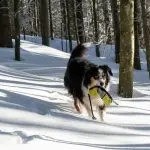
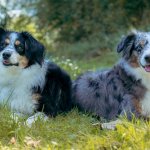


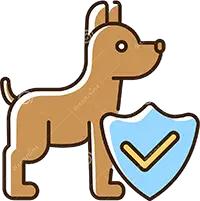

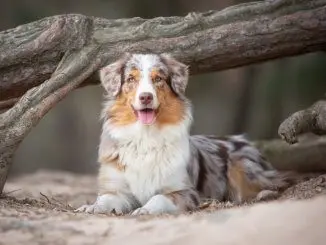
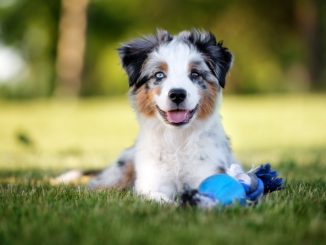

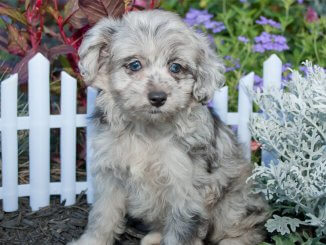
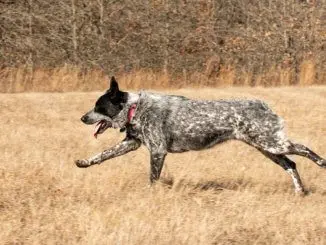
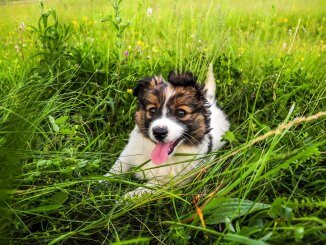
Can someone give me insight on Mini Australian Shepherds vs Labradors? Is one breed more needy than the other? My wife is very familiar with Labs but I would prefer a dog 35 pounds or less so we are doing research on Mini Australian Shepherds now.
I have owned many different breeds…of all the dogs I have owned, none of them compare to our current Mini Aussie Lola. She is by far the most affectionate dog ever! They are called velcro dogs because they follow you around and want to be with you…they need affection and companionship back – if you are looking for a dog to love you – this is it! You need to be able to spend time walking them, playing tennis ball, and most importantly – paying attention to them.
I know this post is from months ago – We have a yellow Lab and a tri colored mini Shepard. Our Lab can be needy if she isn’t given enough attention (walks and play time) but our Shepard is more needy in that she wants someone to love up on her regardless of the activity level she gets. Now I an not saying she is a bother just that I think the mini Shepard requires more attention.
The best one
I had for 14 years a Scott terrier, he was the one. Love him
After 3 years of his dead I gotta my beautiful blue marlin mim Aussie. Lolli is the smart and lovely dog that I ever met
I love my Miniature Aussie, so much so I am now breeding them.. I have bred Labs before and they require alot of space. They love to hunt – anything. Snakes included. Aussies like to herd. Love to keep the cats in line. They are smaller dogs, so they make better dogs for in the house. They are very loveable. Mine sleep with me. I keep her very clean – so she doesn’t shed alot.
Anyone have any tips on potty training an Australian Shepherd?
Feed at same time every day and when puppy take out right after meal time. When a little older do this a little after meal and they learn very fast. Mine is 8 now I take her out after she has breakfast and she good until I get home from work…never a mess
Go to pet trainer .com and follow their instructions.
If you do it right, later on all you’ll have to do is tell your doggie to peepeepoopoo and it ll obey you.
This dog is very obedient.
You have to do the training at first diligently. And before you know it you have the most obedient and best dog ever.
We have two cats. As to compatibility, is a female mini-Aussie more likely to be compatible with them than a male? Can compatibility with cats be taught, or is chasing or herding them an unchangeable character trait?
We have 4 cats…3 males and 1 female. We have 3 mini Aussies and they get along great…even if the cats did not choose to be herded into the corner…
I’m interested a mini Aussie puppy for companionship my rest life. My daily routines are early in the morning 90min.for walking, playing tennis for couple times a week, once of month for gardening. My problems are hard to get a right honest trusty breeder.
2 year old mini with fantastic temperament…just a wonderful girl. She started displaying the following symptoms: anxiety, scratching, swollen anul glands, itching ears, vomiting and lack of hunger or thirst. She’s so uncomfortable that she can’t settle or sleep. The vet relieved the anul glands, but she is still exhibiting the other symptoms. She wouldn’t let the vet examine her ears. Could this be an allergy, bug bite or something else. Has anyone had this problem? We are at a total loss. Many Thanks.
We sure love our toy Aussi he is a joy for us we live in the country on 20 acres and he runs a lot of it and his herd are 2 Cats that he keeps in line but they get along pretty well he is a great little friend to all that come to visit he is our baby